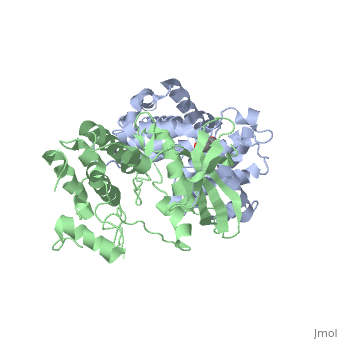2w96
From Proteopedia
Crystal Structure of CDK4 in complex with a D-type cyclin
Structural highlights
DiseaseCDK4_HUMAN Defects in CDK4 are a cause of susceptibility to cutaneous malignant melanoma type 3 (CMM3) [MIM:609048. Malignant melanoma is a malignant neoplasm of melanocytes, arising de novo or from a pre-existing benign nevus, which occurs most often in the skin but also may involve other sites.[1] [2] [3] [4] FunctionCDK4_HUMAN Ser/Thr-kinase component of cyclin D-CDK4 (DC) complexes that phosphorylate and inhibit members of the retinoblastoma (RB) protein family including RB1 and regulate the cell-cycle during G(1)/S transition. Phosphorylation of RB1 allows dissociation of the transcription factor E2F from the RB/E2F complexes and the subsequent transcription of E2F target genes which are responsible for the progression through the G(1) phase. Hypophosphorylates RB1 in early G(1) phase. Cyclin D-CDK4 complexes are major integrators of various mitogenenic and antimitogenic signals. Also phosphorylates SMAD3 in a cell-cycle-dependent manner and represses its transcriptional activity. Component of the ternary complex, cyclin D/CDK4/CDKN1B, required for nuclear translocation and activity of the cyclin D-CDK4 complex.[5] [6] [7] Evolutionary ConservationCheck, as determined by ConSurfDB. You may read the explanation of the method and the full data available from ConSurf. Publication Abstract from PubMedThe cyclin D1-cyclin-dependent kinase 4 (CDK4) complex is a key regulator of the transition through the G(1) phase of the cell cycle. Among the cyclin/CDKs, CDK4 and cyclin D1 are the most frequently activated by somatic genetic alterations in multiple tumor types. Thus, aberrant regulation of the CDK4/cyclin D1 pathway plays an essential role in oncogenesis; hence, CDK4 is a genetically validated therapeutic target. Although X-ray crystallographic structures have been determined for various CDK/cyclin complexes, CDK4/cyclin D1 has remained highly refractory to structure determination. Here, we report the crystal structure of CDK4 in complex with cyclin D1 at a resolution of 2.3 A. Although CDK4 is bound to cyclin D1 and has a phosphorylated T-loop, CDK4 is in an inactive conformation and the conformation of the heterodimer diverges from the previously known CDK/cyclin binary complexes, which suggests a unique mechanism for the process of CDK4 regulation and activation. Crystal structure of human CDK4 in complex with a D-type cyclin.,Day PJ, Cleasby A, Tickle IJ, O'Reilly M, Coyle JE, Holding FP, McMenamin RL, Yon J, Chopra R, Lengauer C, Jhoti H Proc Natl Acad Sci U S A. 2009 Feb 23. PMID:19237565[8] From MEDLINE®/PubMed®, a database of the U.S. National Library of Medicine. See AlsoReferences
| ||||||||||||||||||||
Categories: Homo sapiens | Large Structures | Chopra R | Cleasby A | Coyle JE | Day PJ | Holding FP | Jhoti H | Lengauer C | McMenamin RL | Reilly MO | Tickle IJ | Yon J


